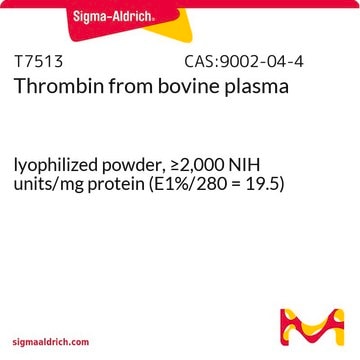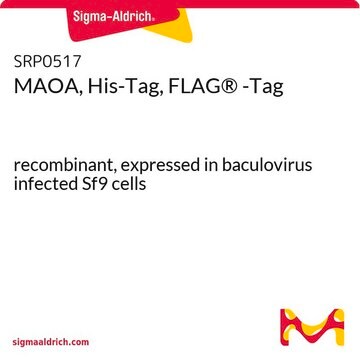SRP0676
Sortase A, S. aureus, His-tag
Staphylococcus aureus, recombinant, N-terminal His-Tag
Synonym(e):
SrtA, sortase A
Anmeldenzur Ansicht organisationsspezifischer und vertraglich vereinbarter Preise
Alle Fotos(1)
About This Item
UNSPSC-Code:
41202061
Empfohlene Produkte
Rekombinant
expressed in E. coli
Markierung
His tagged
Form
liquid
Mol-Gew.
27.7 kDa
UniProt-Hinterlegungsnummer
Lagertemp.
−70°C
Allgemeine Beschreibung
Our comprehensive portfolio of upstream process chemicals not only provides biopharmaceutical manufacturers with high-quality raw materials for production of classical and novel therapies, but also helps them get to market faster and simplify regulatory challenges. Trust us to deliver supply chain transparency and reliable sourcing around the globe, streamlining your product qualification with best-in-class regulatory support and service.
Anwendung
This product is suitable for in vitro ligation of proteins and peptides to other. Sortase A has been shown to create circularized proteins [1], as well as couple polypeptides to a wide range of substituents including polymers [2], lipids [3], fluorophores [4], sugars [5], microspheres [3], peptide nucleic acids [6], among others.
Biochem./physiol. Wirkung
Staphylococcal Sortase A is a bacterial transpeptidase that covalently links proteins to the bacterial cell wall by cleaving between threonine and glycine at an LPXTG recognition motif and catalyzes the formation of an amide bond between the carboxyl-group of threonine and the amino-group of the cell-wall peptidoglycan [7]. This chemistry can be exploited to site-specifically link proteins/peptides with the C-terminal LPETGX motif to other proteins or molecules possessing a glycine or aminomethylene motif [8].
Physikalische Form
Aqueous buffered solution containing: 40 mM Tris-HCl, pH 8.0, 110 mM NaCl, 2.2 mM KCl, 8 mM imidazole, 0.04% Tween-20, and 20% glycerol
Hinweis zur Analyse
Analysis of this product can be performed in a reaction buffer (50 μl) containing 50 mM HEPES (pH=7.4), 150 mM NaCl, 5 mM CaCl2, 5 mM (Gly)3, 25 mM Abz/Dnp substrate, and Sortase A for 30 min at 30°C. Fluorescence intensity is measured at Ex320nm/Em420nm.
Lagerklassenschlüssel
10 - Combustible liquids
WGK
WGK 2
Flammpunkt (°F)
Not applicable
Flammpunkt (°C)
Not applicable
Analysenzertifikate (COA)
Suchen Sie nach Analysenzertifikate (COA), indem Sie die Lot-/Chargennummer des Produkts eingeben. Lot- und Chargennummern sind auf dem Produktetikett hinter den Wörtern ‘Lot’ oder ‘Batch’ (Lot oder Charge) zu finden.
Besitzen Sie dieses Produkt bereits?
In der Dokumentenbibliothek finden Sie die Dokumentation zu den Produkten, die Sie kürzlich erworben haben.
John M Antos et al.
Journal of the American Chemical Society, 130(48), 16338-16343 (2008-11-08)
A general chemoenzymatic method for the site-specific attachment of lipids to protein substrates is described. Sortase A is used to append short lipid-modified oligoglycine peptides to the C terminus of protein substrates bearing a five amino acid sortase A recognition
Hongyuan Mao et al.
Journal of the American Chemical Society, 126(9), 2670-2671 (2004-03-05)
Sortase (SrtA), a transpeptidase from Staphylococcus aureus, catalyzes a cell-wall sorting reaction at an LPXTG motif by cleaving between threonine and glycine and subsequently joining the carboxyl group of threonine to an amino group of pentaglycine on the cell wall
Maximilian W Popp et al.
Proceedings of the National Academy of Sciences of the United States of America, 108(8), 3169-3174 (2011-02-08)
Recombinant protein therapeutics often suffer from short circulating half-life and poor stability, necessitating multiple injections and resulting in limited shelf-life. Conjugation to polyethylene glycol chains (PEG) extends the circulatory half-life of many proteins, but the methods for attachment often lack
Stephan Pritz et al.
The Journal of organic chemistry, 72(10), 3909-3912 (2007-04-17)
Sortase A is a transpeptidase that cleaves at a pentapeptide-motif and subsequently transfers the acyl component to a nucleophile containing N-terminal oligoglycines. We investigate the reaction conditions of the sortase-mediated ligation and demonstrate a useful application by the synthesis of
Maximilian W Popp et al.
Nature chemical biology, 3(11), 707-708 (2007-09-25)
Genetically encoded reporter constructs that yield fluorescently labeled fusion proteins are a powerful tool for observing cell biological phenomena, but they have limitations. Sortagging (sortase-mediated transpeptidation) is a versatile chemoenzymatic system for site-specific labeling of proteins with small (<2 kDa)
Unser Team von Wissenschaftlern verfügt über Erfahrung in allen Forschungsbereichen einschließlich Life Science, Materialwissenschaften, chemischer Synthese, Chromatographie, Analytik und vielen mehr..
Setzen Sie sich mit dem technischen Dienst in Verbindung.








